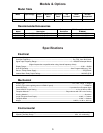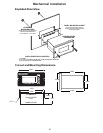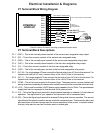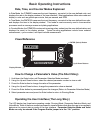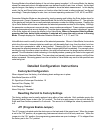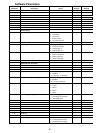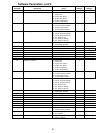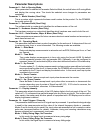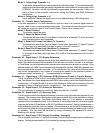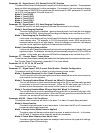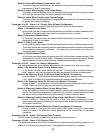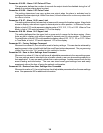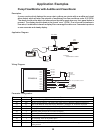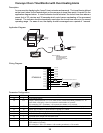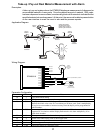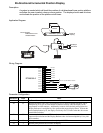11
Mode 3: Falling Edge, Prescaler = 4
In this mode, the signal input is measured at every 4th falling edge. This mode is especially
useful when the signal input frequency is beyond the native pulse-per-minute range of the
DTM8000. Because unit will automatically compensates for the prescaler, there is no
need to factor in the prescaler value when setting the Display and RPM Reference
parameters.
Mode 4: Falling Edge, Prescaler = 16
Same as Mode 3 except the signal input is only measures every 16th falling edge.
Parameter 16 Counter Reset Configuration
In counter applications, it is often desirable to have the user or an external signal reset the
counter value to zero or some predetermined value. This parameter specifies which actions
will cause the counter to reset to the Counter Reset / Preset Value, parameter 27.
Mode 1: Reset Disabled
The counter cannot be reset.
Mode 2: Reset On Button Press
The counter will reset to the Counter Reset / Preset Value, parameter 27, when any of the
user-interface buttons are depressed.
Mode 3: Reset On S2 Input Low (Wired To Common)
The counter will reset to the Counter Reset / Preset Value, parameter 27, when S2 (signal
2) is brought to an electrically low state or wired to the unit's common.
Mode 4: Reset On S2 Input High (Not Wired To Common)
The counter will reset to the Counter Reset / Preset Value, parameter 27, when S2 (signal
2) is brought to an electrically high state (+5V) or left to float disconnected from the unit's
common.
Parameter 20 Signal Input 1 (S1) Display Reference
This is the number to be displayed when at the user-specified motor Reference RPM. In Rate
Mode, this value represents the numerator of the rate unit such as feet, ounces, or revolutions.
In Time Mode, this value represents the reference time measured in seconds or minutes. If the
desired display is HH:MM, then all values should be entered in minutes. If MM:SS is desired, then
all values should be entered in seconds. In Counter Modes, this value is the reference count
ratio which corresponds to the number of counts which equate to the specified number of
reference pulses, parameter 21. See applications for examples.
Parameter 21 Signal Input 1 (S1) Reference RPM (Reference Pulses in Counter Modes)
This is the reference RPM at which the Display Reference value should be displayed. In Rate
and Time Modes, this value represents the RPM of the encoder to which the Display Reference
corresponds. In Counter Modes, this value is the Reference Pulses which correspond the the
specified number of displayed counter, parameter 21. See applications for examples.
Parameter 22 Signal Input 1 (S1) Pulses per Revolution
This is the number of pulses per revolution. Value may be from 1 to 9999.
Parameter 23 Signal Input 1 (S1) Recovery Rate
This is the rate at which the display will attempt to recover once the pulse train appears to have
stopped. The recovery rate is the number of half seconds which the unit will wait before dividing
(Rate Mode) or multiplying (Time Mode) the display value by 2 in an attempt to accurately
represent the current speed or time. In the absence of input pulses, this will continue at regular
intervals until either 0 (Rate Mode) or 99:99 (Time Mode) is reached. Setting this parameter to
0 will disable the automatic recovery feature. If this parameter is set too low for the application,
the division or multiplication may prematurely occur causing the reading to read too high, too low,
or unstable. This can easily be corrected by simply increasing this parameter's value or
disabling it by setting it to zero.
Parameter 24 Signal Input 1 (S1) Display Smoothing / Averaging
This is the amount of time, in 1-second increments, which will be averaged before updating the
display. Setting this parameter to 0 will disable the averaging feature.



